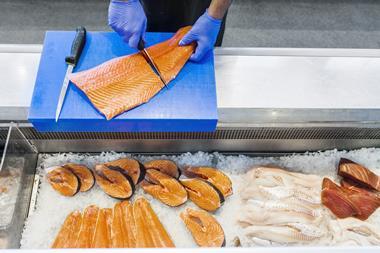Scottish aquaculture products are predicted to be worth more than £100m by 2010, the British Marine Finfish Association's executive director Richard Slaski said at its annual meeting.
Slaski's vision includes annual production of 25,000 tonnes of cod, 5,000 of haddock and 10,000 of halibut.
Current production of marine finfish is about 800 tonnes of cod and 400 tonnes of halibut, with a first sale value of about £4m, while haddock is still undergoing commercial viability trials.
Traditional species grown in Scotland, including salmon, trout and shellfish, are already worth about £300m and are also predicted to increase over the next decade.
Marine Harvest is the UK's major supplier of farmed halibut, which it markets as a whole gutted product, weighing 3-11kg, to multiples and wholesalers.
Aquascot, the country's leading producer of farmed cod, sells whole fish plus portions and fillets in pre-pack form, mainly to multiple retailers.
Aware that the key issue in developing the industry over the next few years is its ability to be sustainable, the BMFA is participating in a number of R&D projects on all aspects of marine finfish farming.
Marks and Spencer is actively involved in the project to grow haddock in aquaculture and is playing a crucial role in the development of cod farming.
Given the crisis on white fish stocks, the BMFA is keen to see its ambitious plans get financial and political support.
Meanwhile, Scottish fishermen, who face the prospect of a ban on cod fishing, hope the langoustine, or Dublin Bay prawn, could be their salvation. After an explosion in the prawn's popularity, Scottish fishing leaders are calling for EU quotas to double to allow white fish boats to switch.
They claim declining cod numbers have allowed a langoustine boom.
{{MARKET EDGE }}
Slaski's vision includes annual production of 25,000 tonnes of cod, 5,000 of haddock and 10,000 of halibut.
Current production of marine finfish is about 800 tonnes of cod and 400 tonnes of halibut, with a first sale value of about £4m, while haddock is still undergoing commercial viability trials.
Traditional species grown in Scotland, including salmon, trout and shellfish, are already worth about £300m and are also predicted to increase over the next decade.
Marine Harvest is the UK's major supplier of farmed halibut, which it markets as a whole gutted product, weighing 3-11kg, to multiples and wholesalers.
Aquascot, the country's leading producer of farmed cod, sells whole fish plus portions and fillets in pre-pack form, mainly to multiple retailers.
Aware that the key issue in developing the industry over the next few years is its ability to be sustainable, the BMFA is participating in a number of R&D projects on all aspects of marine finfish farming.
Marks and Spencer is actively involved in the project to grow haddock in aquaculture and is playing a crucial role in the development of cod farming.
Given the crisis on white fish stocks, the BMFA is keen to see its ambitious plans get financial and political support.
Meanwhile, Scottish fishermen, who face the prospect of a ban on cod fishing, hope the langoustine, or Dublin Bay prawn, could be their salvation. After an explosion in the prawn's popularity, Scottish fishing leaders are calling for EU quotas to double to allow white fish boats to switch.
They claim declining cod numbers have allowed a langoustine boom.
{{MARKET EDGE }}








No comments yet